Hand-held circular saws and their use
Whether building a new wooden terrace, a carport, or working on DIY projects – if you want clean, straight cuts of panels, beams, or other elements, the handheld circular saw is your tool of choice! Not only wood, but also other materials like plastic or metal can be optimally worked on with a circular saw and a suitable saw blade. There are different models for the various requirements.
In this article, you will learn about the different models and designs, how to saw safely and securely, and other interesting tips and tricks, for example, for tear-free cuts.

Different types of hand-held circular saws
The classic hand-held circular saw
With a circular saw, you can make long, straight cuts in various materials. To do this, the saw is placed from above and at the edge of a workpiece using the base plate, and then guided along a straight line through the wood. Circular hand saw models primarily differ in power and cutting depth. The base plate, also called the saw shoe, can be adjusted for miter cuts in its inclination, usually even without tools depending on the saw model. The saw blade is covered by a retractable blade guard, with the upper blade guard fixed and the lower blade guard retracting backward during the sawing process.
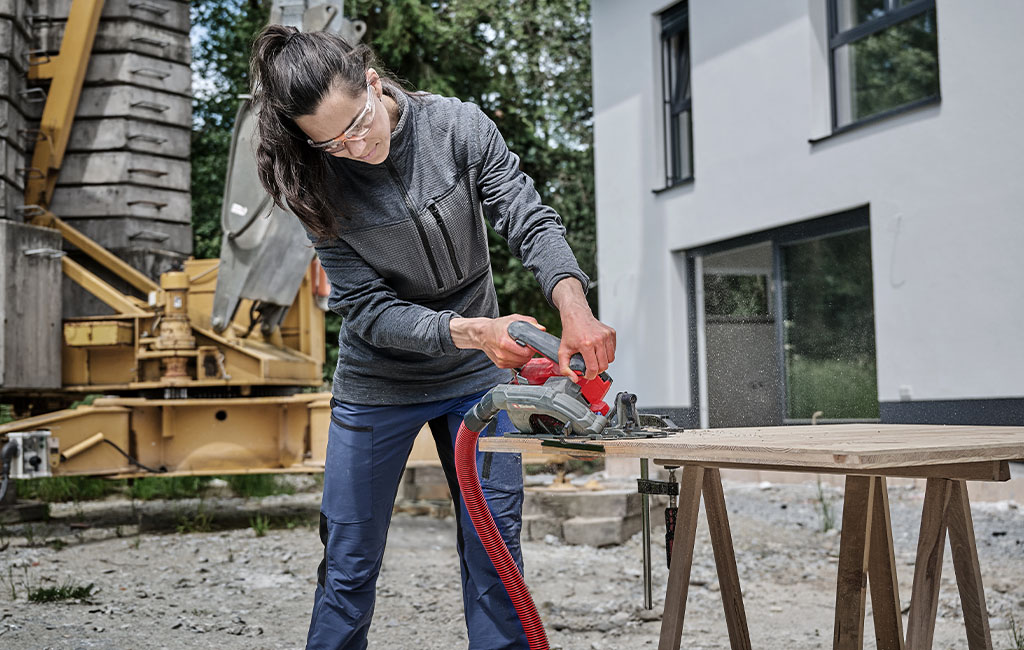
For less dust exposure and to keep the workspace clean, the saws are equipped with a dust extraction adapter, to which you can connect a wet-dry vacuum for extracting sawdust. Certain circular saw models have a base plate with an integrated groove for use with a guide rail. Other helpful features include an adjustable saw blade height or cutting depth, a spindle lock for easy blade changes, or an integrated LED light for the best view of the cutting area.
Hand-held circular saws are now available not only with cables but also as battery-powered devices. Our Power X-Change cordless circular saws can be combined with all batteries and chargers in the system family. Cordlessly flexible, the battery-powered saws are particularly suitable for use away from power outlets. If you have your battery ready, you won't need a cable reel or extension cord to cut your wooden terrace.
What is a pendulum hood saw?
"Pendulum hood saw" is actually just another term for a classic hand-held circular saw. The name comes from the fact that the saw blade is fixed in place and the guard "swings", that is, it pivots upward when the saw is applied to the workpiece. In the case of a plunge saw, the guard remains fixed, but the saw blade is "plunged" into the workpiece within the guard.
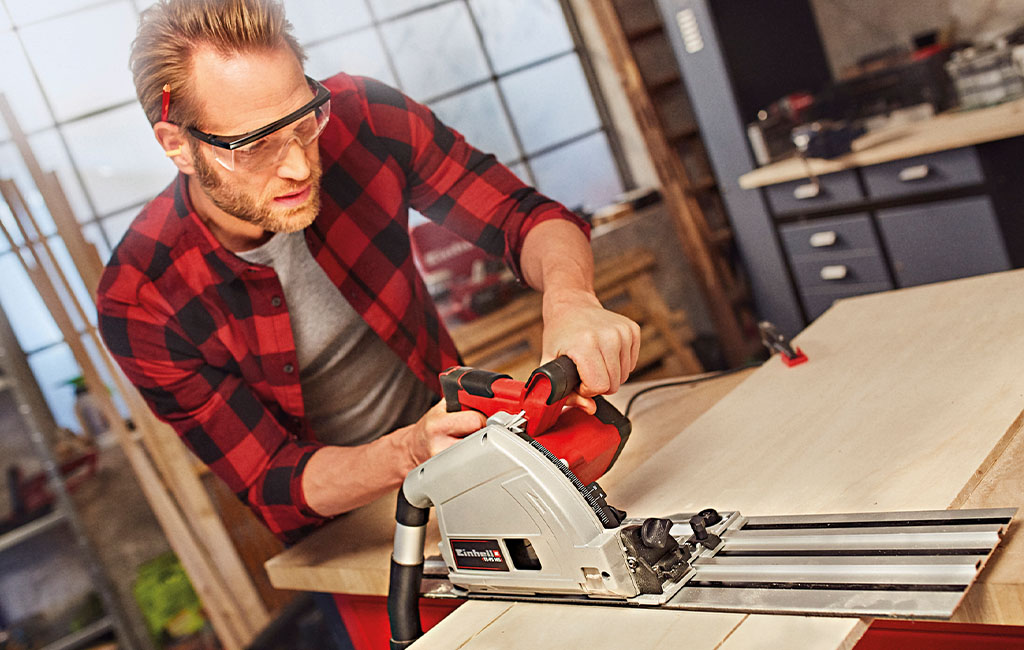
The plunge saw as a specialist
Circular saws and plunge saws are similar – but differ in function and application. Plunge saws have a different design: The base plate is fixed to the body, and the circular saw blade plunges from top to bottom through the base plate into the workpiece. This makes it easy to make cut-outs in kitchen countertops, for example.
The plunge saw does not necessarily need to be applied at the edge of a workpiece. Instead, you place the plunge saw on the panel where you want to start the cut and guide the saw blade into the workpiece from above thanks to the plunge function. Since the saw blade is positioned further out compared to a regular circular hand saw, it is also possible to cut shadow gaps, for example, for paneling work.
The mini circular saw
Small and handy, the mini circular saw is a plunge saw in a compact format. It has a smaller saw table through which the saw blade plunges from above into the workpiece. This allows for not only straight, long cuts but also cut-outs with ease. The compact design and smaller saw blade make it particularly easy to cut precisely and with detail.
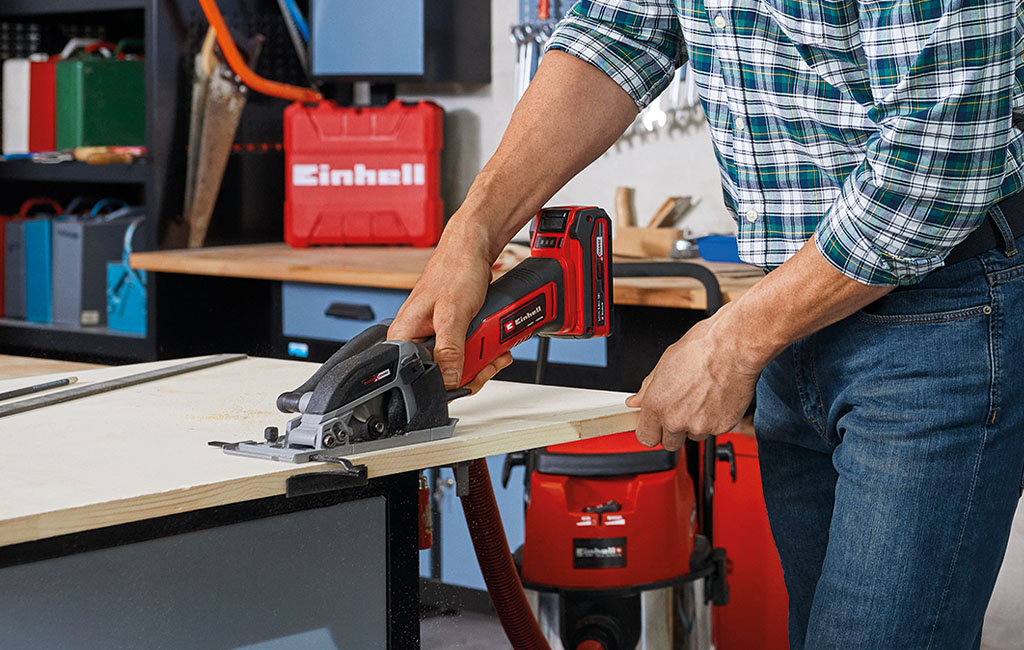
The maximum cutting depth always depends on the specific saw model and the saw blade used. Since the mini circular hand-held saw only works with smaller saw blades, such as Ø 89 mm, only smaller cutting depths of up to approximately 28 mm are possible.
How to Properly Use a Handheld Circular Saw?
To achieve clean, splinter-free, and precise cuts in wood, you should keep a few things in mind while working with a handheld circular saw.
- Cutting Depth and Cutting Line: Before you start, you should set the correct cutting depth on your circular saw. You will get the best cutting results by using the scale on the device to set a cutting depth that corresponds to the material thickness plus an additional 5 mm, so that the saw blade cuts through the entire material. By the way: If it is important to cut exactly to the millimeter, be aware that the saw always removes a bit of material. This means that the newly cut end of your workpiece will always be right next to the indicated cutting line. The cutting line itself indicates where exactly the saw blade will cut through the material.
- Proper Positioning: Generally, you should place the circular saw on your workpiece in the off state and only start cutting once the saw blade has reached its full speed. Then you can carefully and without pressure guide it forward through the material, achieving a clean cut.
- Long, Straight Cuts: For straight cuts, cutting multiple strips of wood, or trimming, the parallel guide is helpful. For precise cuts, you should always position the parallel guide along a straight edge along which the circular saw is guided. By maintaining the setting of the parallel guide, you can quickly cut several strips of wood to the same width.
- Miter Cut: For the perfect miter cut, you must first set the correct tilt angle on the handheld circular saw. With Einhell models, this is done easily and without additional tools in just a few steps. You can read and set the exact cutting angle on the integrated scale. Then, as usual, position your saw on the workpiece and cut exactly at the preset angle.
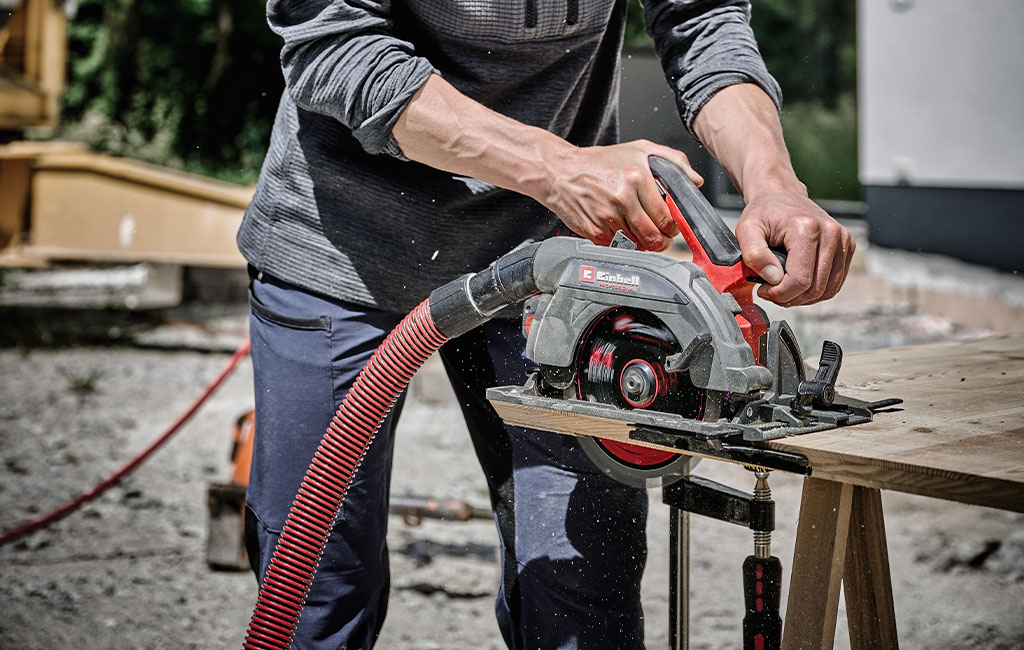
Useful Accessories for Handheld Circular Saws
Guide Rail
The most useful accessory for a handheld circular saw is the guide rail. This is usually not included with the saw itself but is available separately as an accessory. With a guide rail, perfectly straight cuts are possible because the circular saw can be securely guided over the workpiece thanks to a groove in the rail. Guide rails are equipped with a rubber lip that lies directly against the saw blade to minimize splintering.
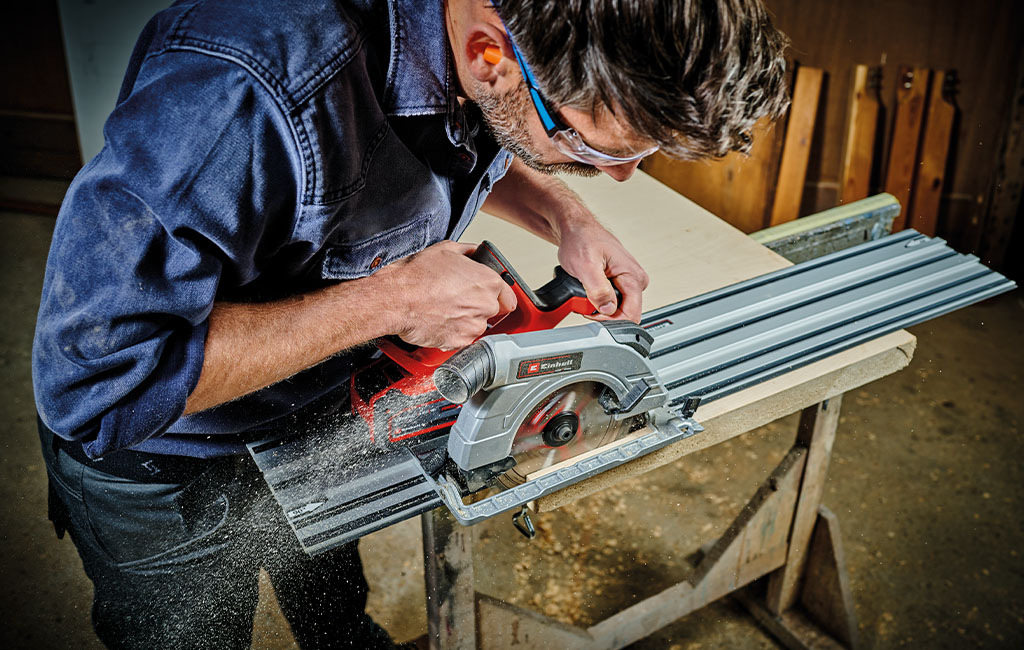
It is best to read the corresponding instruction manual beforehand to learn exactly how to assemble and attach the guide rail. It is important to securely and straightly attach the guide rail to the workpiece using clamps. The workpiece itself should also be securely fixed. Depending on the model of the handheld circular saw, the cutting depth must be adjusted because the thickness of the rail must be added to the material thickness so that the saw cuts completely through the material. The handheld circular saw is guided along the guide rail on the workpiece, with the rubber lip minimizing splintering and preventing the material from fraying.
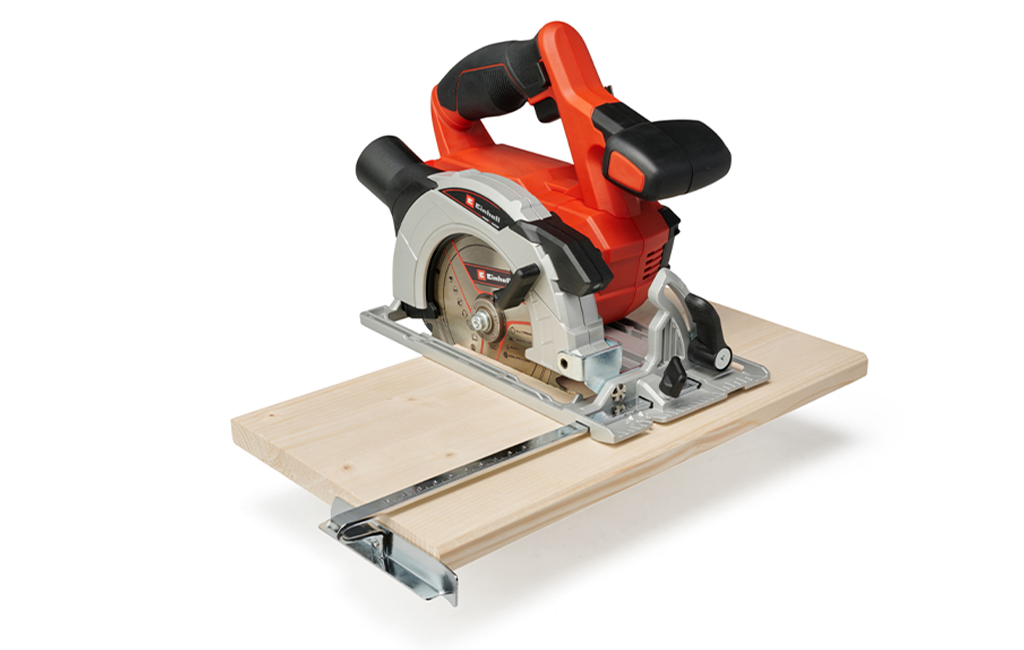
Parallel Guide
The parallel guide is very useful when you need to cut large sheet materials across their width or cut strips from a sheet. It is important to have a straight edge as a stop for the parallel guide to achieve a clean cut.
Appropriate Saw Blades
Before you start working, you should choose the appropriate circular saw blade. The saw blade must fit your circular saw in terms of both blade diameter and bore diameter. Additionally, it should be suitable for the material of your workpiece.
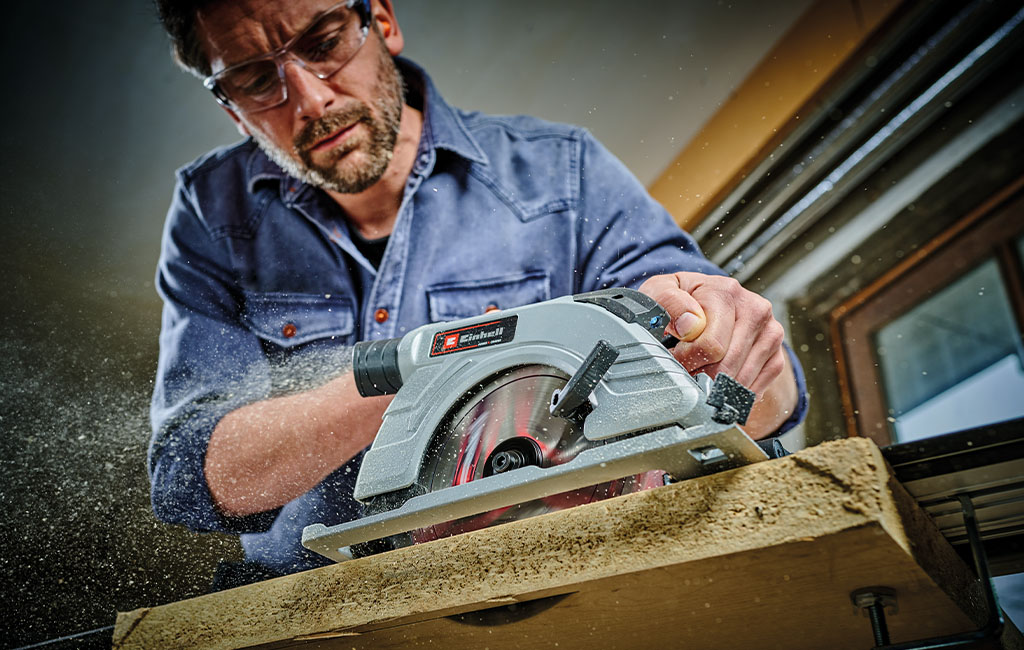
For working with softer material, you can use a circular saw blade made of CV steel (chrome-vanadium), as these have high elasticity and enable a high cut quality. If you want to work with hardwood or perform many cross and rip cuts, carbide-tipped circular saw blades are suitable due to their long service life. The carbide-tipped saw blades are also versatile, as they are suitable not only for hardwood but also for various types of wood, including softwood, plywood, or the classic chipboard. The number of teeth also plays a role, with the general rule being: the more teeth, the finer the cut.
Tips for Safe Use of Handheld Circular Saws
Long-lasting Use: Protection and Maintenance of the Saw
- Protect the Cable: If you want to enjoy your machine for as long as possible, you should always protect your saw from damage. When working with a corded handheld circular saw, make sure to always route the cable with a large distance from the saw blade to the nearest socket to avoid accidentally cutting the cable. It is easier and safer to use a cordless circular saw from our Power X-Change family.
- Check the Saw Blade: Always pay attention to the condition of your saw blade! Precise cuts can only be achieved with sharp saw blades! You should never continue using dull or damaged saw blades with missing teeth, as precise cuts can only be achieved with sharp saw blades.
- Changing the Saw Blade: You should read the instruction manual beforehand to learn how to change the circular saw blade. In any case, you must disconnect the handheld circular saw from the power source, either by unplugging it from the socket or removing the battery in the case of a cordless saw. To avoid injury, you should wear protective gloves when changing the saw blade.
Safety Tips for Working
When working with handheld circular saws, always exercise caution to protect yourself from injuries. One hazard with a high risk of injury is loose clothing, which can get caught in the saw blade. Therefore, it is recommended to wear tight-fitting clothing while working with saws. To protect your eyes and respiratory system from chips and wood dust, you should also wear safety goggles and a dust mask. By the way, you can connect a suitable wet-dry vacuum to the dust extraction adapter of the circular saw to minimize dust exposure, keep the workspace clean, and have a better view of the workpiece. Naturally, the circular saw is not silent. Hearing protection will safeguard your ears from excessive noise.
To protect both yourself and your device, you should never tamper with the machine, such as removing the blade guard or the pendulum guard. This could potentially affect the functionality of your handheld circular saw or lead to injuries during use.

Conclusion: Working with a Handheld Circular Saw
A handheld circular saw is the tool of choice for long and straight cuts. Modern handheld circular saws are no longer as bulky and heavy as they used to be. With the right accessories, especially sheet materials can be cut very precisely. For those who like to be mobile, we recommend our cordless handheld circular saws.












